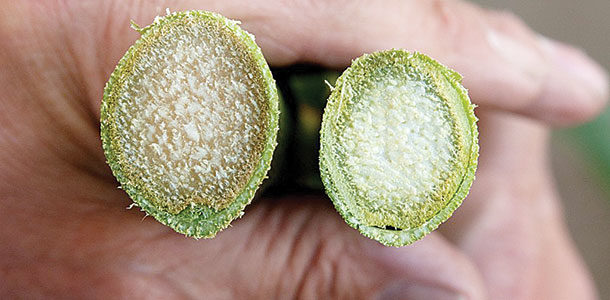Dairy producers across the country who feed BMR corn silage are building on 90 years of research and development. BMR was first found as a naturally occurring gene mutation in dent corn in 1924 at the University of Minnesota – St. Paul. Leaves of BMR corn feature a distinct brownish-colored midrib vein.
But the most meaningful feature for dairy producers is the lower lignin content in BMR corn stalks compared with conventional corn. Lower lignin means better fiber digestibility for dairy cows.
“Because it doesn’t have as much lignin, BMR digests easier and often results in greater intake by cows, providing potential for greater milk production,” says Jeff Coulter, University of Minnesota Extension specialist.
Although BMR corn silage is widely used today, it wasn’t immediately accepted by dairy producers. Since the discovery of BMR, corn breeders and nutrition researchers have learned the best ways to utilize the forage and prove the value to dairy operations.
Harnessing BMR’s promise
BMR has shown great potential from the beginning. Researchers recognized the significance of the gene mutation but did not start studying the benefits as feed for dairy herds until the 1970s.
At that time, researchers conducted feeding studies using four known BMR gene mutations: bm1, bm2, bm3 and bm4. They discovered the bm3 gene had a dramatic advantage in digestibility with the lowest lignin content over other mutations. So far, bm1 is the only other BMR gene that is commercially available.
Early BMR feeding trials with bm3 showed increases as high as 6 to 7 pounds of milk per cow per day – a significant improvement compared with conventional corn. Cargill began its BMR breeding program in the 1980s, introducing the first BMR corn silage to the market on a very small scale in 1996.
Those first-generation hybrids did not have the agronomic characteristics, standability and yield that are features of current BMR hybrids. Although there were proven advantages in fiber digestibility, it took a few years for BMR agronomics to catch up.
BMR showed tremendous promise, even though first-generation hybrids did not show as well in the field as the BMR did in the ration.
First-generation hybrids pave way for improvements
Silage research continued and breeders infused disease-tolerant genes into the hybrids containing the bm3 gene to address plant health. With this modification, yield improved. Continued breeding efforts also improved standability.
As research progressed, agronomics improved. BMR turned a corner in the early 2000s with strengthened standability and corn silage yield compared with first-generation BMR hybrids. The BMR introduced nearly 20 years ago is not the product we have in the field today. The success of today is the result of hard work, focused breeding, product development and dedication by a lot of people.
Early BMR adopter
Dairy producer Dan Natzke with Wayside Dairy in Greenleaf, Wisconsin, was among the first to use BMR. At first, Natzke says, Wayside Dairy planted BMR on only its best acres, starting with about 100 acres on his 400-cow dairy farm. Natzke has planted BMR ever since, based on the advice of his nutritionists and improved agronomics.
“BMR hybrids have made gains in standability, disease resistance and tonnage,” Natzke says. “They’ve made strides over the years, and we’ve always hung with them, and all along, we’ve had supportive nutritionists who have said, ‘BMR is a good product,’ ‘We know how to use it,’ and ‘Let’s make it work.’”
Now the dairy plants longer-day varieties of BMR on 1,600 acres to feed its 1,750 cows. Natzke says the higher digestibility of BMR corn silage helps improve dry matter intake and milk production.
“We’re feeding a higher percentage of corn silage as forage in the diet because of BMR and getting a production response from BMR,” Natzke says. “We’ll continue to use BMR as long as my nutritionist continues to recommend it.”
University trials show that cows fed BMR corn produce an average of 4.8 more pounds of milk per day. After seeing that data, nutritionists really began to understand fiber digestibility and the benefits to production.
Determining forage digestibility has been a work in progress. Great strides have been made in forage testing and ration formulation since the 1990s, and today’s bm3 BMR hybrids show that, more than ever; they are a great fit for high-producing dairy herds. PD
PHOTO
BMR corn silage is held next to conventional corn to show the difference in the lignin content in the stalk as the rind is smaller, an indication of lower lignin. For cows, lower lignin means higher fiber digestibility. Photo courtesy of John Anderson.

John Anderson
Dairy Nutritionist
Mycogen Seeds







